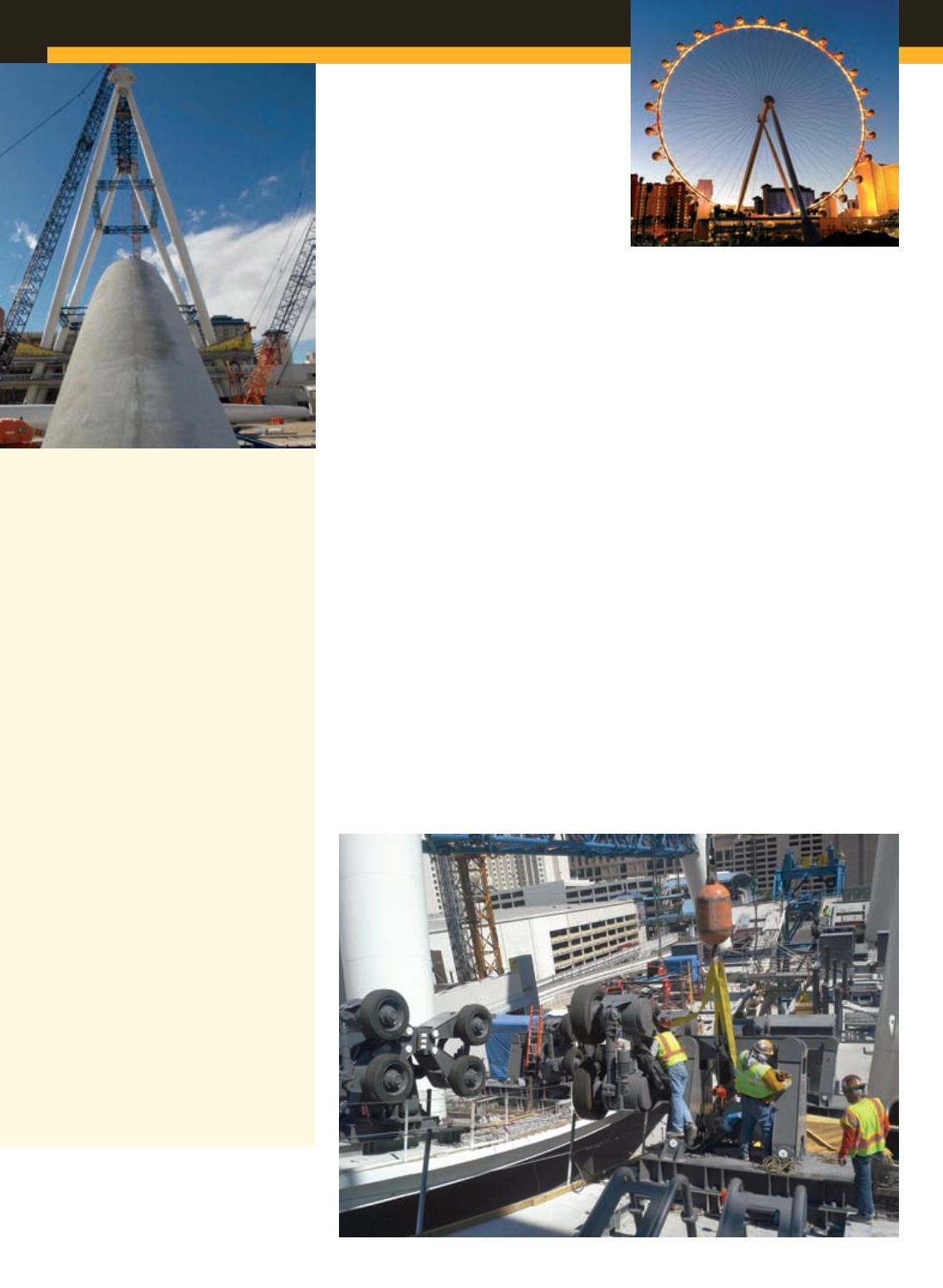
78
SITE REPORT
RIGGING
ACT
MARCH 2014
mounted on a 71-foot temporary holdback
tower designed separately by American
Bridge and Zieman to commission the
system.
The HRM was installed and operated by
American Bridge and used to safely grip,
hold and turn the rim while it was being
constructed. Sometimes referred to as
“gripper boxes,” the HRM has a 750-ton
gripping, holding and moving capacity.
The HRM consisted of six gripper boxes,
three per side of the rim, which were
operated by two hydraulic power units and
a single computer control station.
The 45-ton rim sections were rolled onto
a platform on dollies and positioned at the
bottom of the platform in accurate, dead
center position. The HRM was attached
to the first three rims, then the wheel was
rotated and the wheel structure began to
take shape.
Steady hands
The ironworkers running the HRM
needed steady hands and cool heads to
manage the massive loads and delicate
process. The normal erection sequence
included rotating the rim using the HRM,
erecting temporary radial struts, erecting
the permanent cable spokes of the wheel,
and then rolling in the next rim section.
After the final rim section was carefully
put in place, the temporary radial
struts were removed and the remaining
permanent cable spokes were installed.
Finally, the HRM system was removed
Tall job
Las Vegas-based Dielco Crane Service
provided most of the lifting work for the
High Roller Observation Wheel using three
cranes: a 750-ton capacity Liebherr LR
1750, a 300-ton Manitowoc 2250 and a
75-ton capacity Grove rough terrain crane.
Most of the heavy lifting was performed by
the two crawlers, which erected the wheel
support systems, the center hubs and then
all the segments. The rough terrain crane
was a workhorse at the jobsite, providing
lifting services in the lay-down yard.
Among the largest picks was the spindle/
bearing assembling that weighed 187 tons.
Challenging aspects of the job included a
very tight working area. In many cases, the
components of the wheel had to be landed
on false work in the air.
According to a spokesman with Dielco, the
job was “extremely well engineered and well
thought out by American Bridge.”
The job went off without a hitch, he said.
The cranes were on the job for about a year.
The 22-ton observation cabins were
trucked to the site by Empire Transport.
They were lifted off the lowboy delivery
trailer onto the custom-made lifting frame
before being repositioned under the rim
before installation.
and the hold back tower was dismantled.
The completed 469-foot diameter wheel is
connected to the hub by 112 cable spokes
made from 75 mm diameter locked coil
cables.
The Enerpac HRM system proved to be
instrumental in the erection of the wheel.
American Bridge acknowledged that they
could not have built this wheel without the
HRM system provided by Enerpac.
In addition to the HRM, Enerpac worked
with Schwager Davis Inc. to supply the
Mechanization System, which is the
permanent drive system used to operate
the wheel. The drive system was also used
for several weeks in the construction of the
wheel to turn the wheel in order to install
the large 25-ton passenger cabins.
The completion of this project was done
with stunning efficiency, according to
Enerpac. The amazing structure and its
assembly was all achieved with careful
planning and smooth execution involving
numerous suppliers, subcontractors,
vendors and consultants who supported
each other in innovative ways that
contributed immeasurably to the success
of the project.
The High Roller is scheduled to open in
April 2014.
■
Enerpac also worked with Schwager Davis
to develop and supply the mechanization
system, which is the permanent drive system
used to operate the wheel.
Dielco Crane had three cranes on the job:
a 750-ton capacity Liebherr LR 1750, a
300-ton Manitowoc 2250 and a 75-ton
capacity Grove rough terrain crane.
The completed 469-foot diameter wheel is
connected to the hub by 112 cable spokes.
PHOTO: LAS VEGAS NEWS
BUREAU, BRIAN JONES


